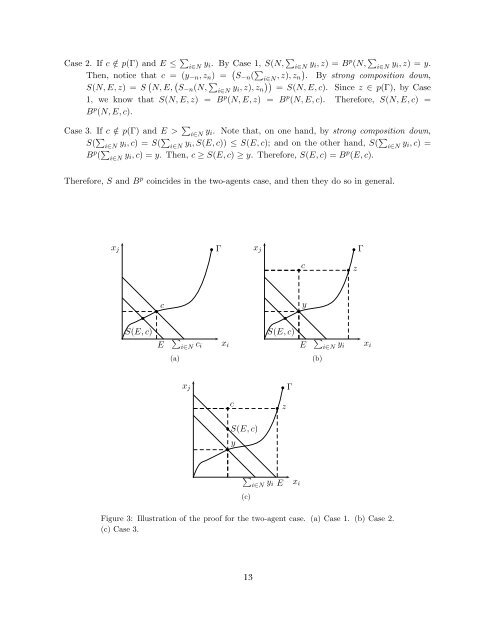Appendix A. Proofs This appendix is devoted to the proof of Theorem 3.1, preceded by some definitions and technical results. Resource monotonicity stipulates that no agent is penalized as a consequence of an increase in the estate. Resource monotonicity. For each e = (N,E,c),e ′ = (N,E ′ ,c) ∈ C, if E ′ > E, then S(e ′ ) ≥ S(e). Let us consider an awards vector with the following feature. For each two-agent subset, the rule chooses the restriction of that allocation for the associated reduced problem to this agent subset. Converse consistency requires that the allocation is the one selected by the rule for the original problem. 7 Let c.con(e;S) ≡ {x ∈ R N + : ∑ i∈N x i = E and for all N ′ ⊂ N such that |N ′ | = 2,x N ′ = S(N ′ , ∑ i∈N ′ x i,c S )} Converse consistency. For each e ∈ C, c.con(e;S) ≠ φ, and if x ∈ c.con(e;S), then x = S(e). Lemma 5.1 (Elevator Lemma, Thomson (1998)). If a rule S is consistent and coincides with a conversely consistent rule S ′ in the two agent case, then it coincides with S ′ in general. Proposition 5.1 (Chun (1999)). Resource monotonicity and consistency together imply converse consistency. Proof of Theorem 3.1. It is not difficult to check that any backbone rule satisfies strong composition down and consistency. It is also straightforward that strong composition down implies composition down and the latter resource monotonicity. Therefore, in application of Proposition 5.1, any backbone rule is converse consistent. Let S be a rule fulfilling strong composition down and consistency. Let us define the path p = p S (Γ) as the path of awards of rule S for claims vector Γ. We show that S = B p . By the Elevator Lemma, it is enough to prove the result in the two-agents case. We assume that N = {i,j} and c i ≤ c j . For a given claims vector c, let y ∈ p(Γ) be a vector such that y i = c i and y j < c j . And let z ∈ p(Γ) be a vector such that z j = c j and z i > c i . We distinguish several cases. Case 1. If c ∈ p(Γ). Let E ∈ [0, ∑ i∈N c i]. Note that, since c ∈ p(Γ), S(N, ∑ i∈N c i,Γ) = c by definition of path of awards. Then S(N,E,c) = S(N,E,S( ∑ i∈N c i,Γ)). By strong composition down, S(N,E,S( ∑ i∈N c i,Γ)) = S(N,E,Γ) = B p (N,E,Γ) = B p (N,E,c). Therefore, S(N,E,c) = B p (N,E,c). 7 This property was formulated by Chun (1999). 11
• • • • • • • • • • • • • Case 2. If c /∈ p(Γ) and E ≤ ∑ i∈N y i. By Case 1, S(N, ∑ i∈N y i,z) = B p (N, ∑ i∈N y i,z) = y. Then, notice that c = (y −n ,z n ) = ( S −n ( ∑ i∈N ,z),z n) . By strong composition down, S(N,E,z) = S ( N,E, ( S −n (N, ∑ i∈N y i,z),z n )) = S(N,E,c). Since z ∈ p(Γ), by Case 1, we know that S(N,E,z) = B p (N,E,z) = B p (N,E,c). Therefore, S(N,E,c) = B p (N,E,c). Case 3. If c /∈ p(Γ) and E > ∑ i∈N y i. Note that, on one hand, by strong composition down, S( ∑ i∈N y i,c) = S( ∑ i∈N y i,S(E,c)) ≤ S(E,c); and on the other hand, S( ∑ i∈N y i,c) = B p ( ∑ i∈N y i,c) = y. Then, c ≥ S(E,c) ≥ y. Therefore, S(E,c) = B p (E,c). Therefore, S and B p coincides in the two-agents case, and then they do so in general. [Insert Figure 3 about here.] x j Γ x j Γ c z c y S(E,c) S(E,c) E ∑ i∈N c i x i E ∑ i∈N y i x i (a) (b) x j Γ c z S(E,c) y ∑ i∈N y i (c) E x i Figure 3: Illustration of the proof for the two-agent case. (a) Case 1. (b) Case 2. (c) Case 3. 12

















